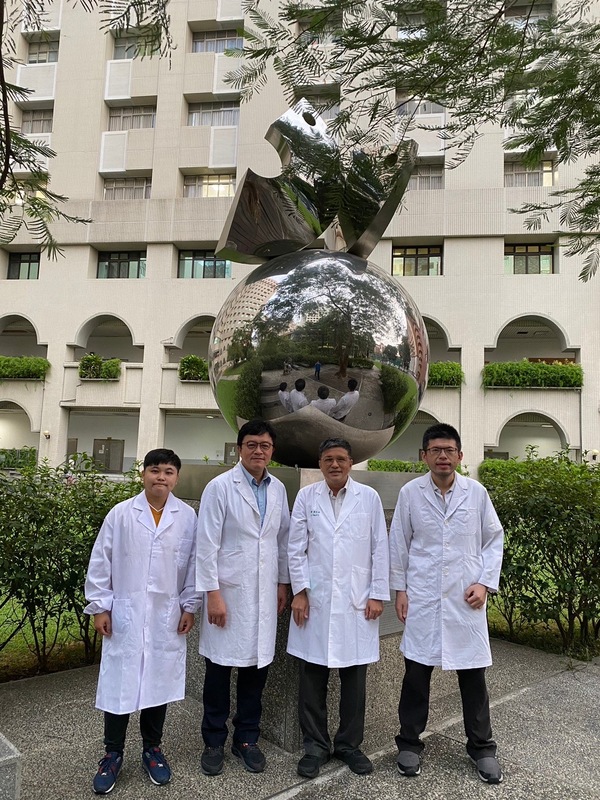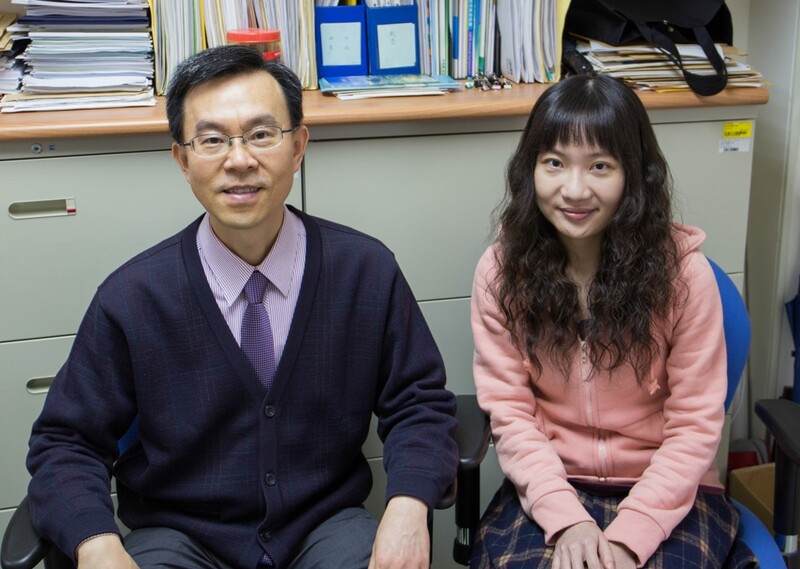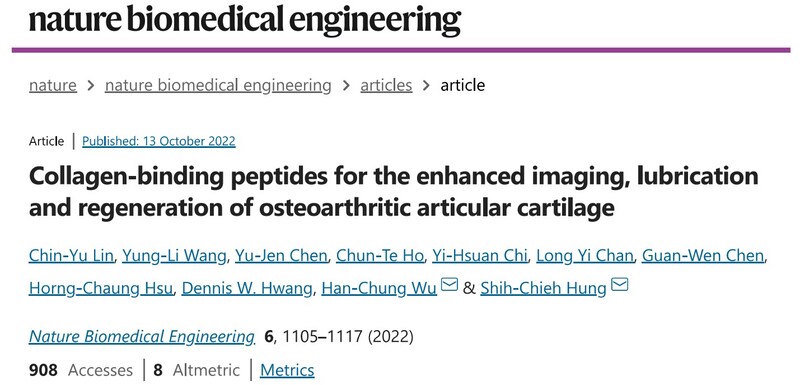中國醫藥大學新藥開發研究中心主任洪士杰特聘教授帶領的研究團隊與中央研究院生醫轉譯研究中心主任暨細胞與個體生物學研究所特聘研究員吳漢忠團隊合作,成功開發專一辨識結合骨關節炎軟骨膠原蛋白的胜肽及雙功能單一胜肽,具有促進骨關節炎早期診斷、治療和骨關節炎之再生醫學潛力,也可應用促進角膜缺損之表層及內膜再生,這項研究成果於10月刊登國際知名期刊《自然生醫工程》Nature Biomedical Engineering,受到骨科醫學專家的廣泛關注。
這項研究成果『膠原結合胜肽用於增強骨關節炎關節軟骨的成像、潤滑和再生』並取得國家專利,預計兩年內開展臨床試驗,應用於臨床患者的診斷和治療,為骨關節炎診斷及治療新策略。「運動或爬山後膝蓋疼痛加重,醫生說是骨關節炎,沒有辦法改變或治愈?醫生要求我停止鍛煉或攀爬,否則我可能需要進行關節置換手術;我對運動和登山充滿熱情,我應該怎麼辦?」
這種內心的掙扎和困惑經常發生在因膝蓋疼痛去看醫生的骨科患者身上。不過,這種情況有望在未來得到改善,因為骨關節炎的治療將受益於核磁共振上受損關節軟骨的成功可視化,以及疾病緩解藥物或再生製品的靶向遞送。
中國醫藥大學新藥開發研究中心主任洪士杰特聘教授帶領林進裕博士、何俊德博士,陳朗兒研究生,並與關節中心許弘昌副院長,及中央研究院生醫轉譯研究中心主任暨細胞與個體生物學研究所特聘研究員吳漢忠教授、紀怡亘博士及生物醫學研究所黃聖言長聘副研究員團隊合作,利用噬菌體表現胜肽篩選系統(phage peptide display system),成功開發出一系列的短鏈胜肽,具有專一辨識結合骨關節炎軟骨膠原蛋白的能力,且其對於關節腔內非關節軟骨區域的非專一性附著程度相當的低。
研究團隊發現當與超順磁性氧化鐵結合時,這些膠原結合胜肽藉由核磁共振成像用於早期骨關節炎診斷。與使用具有亂序序列的胜肽相比,經膠原結合胜肽修飾的玻尿酸在骨關節炎軟骨中的留存增加,在離體人骨關節炎組織中的潤滑效果更好。
洪士杰特聘教授表示,以胜肽修飾過的玻尿酸來遞送間質幹細胞,在骨關節炎大鼠膝關節內注射的間質幹細胞顯示增強的歸巢能力,並改善骨關節炎軟骨組織的再生。分子對接實驗顯示該膠原蛋白結合胜肽具有膠原蛋白12的靶向性,且研究結果表明膠原蛋白12在其他組織中也有表達,如退化和受損的椎間盤、眼角膜基質、皮膚真皮和毛囊周圍。這種骨關節炎膠原蛋白結合胜肽的應用將有助於開發用於診斷、潤滑和治療骨關節炎關節的新策略。
研究團隊進一步發展具有膠原蛋白12靶向及細胞結合雙功能之單一胜肽(Bifunctional peptide, BiFP)。最新實驗結果顯示BiFP可以遞送間質幹細胞至骨關節炎軟骨表面再生出多層軟骨及再生角膜表皮層。這些結果表明此膠原結合胜肽具有促進骨關節炎早期診斷、治療和骨關節炎之再生醫學的潛力。未來也可以應用於攜帶間質幹細胞或輪部幹細胞來促進角膜缺損之表層及內膜再生以取代角膜移植。
洪士杰特聘教授說,這項研究成果也已取得專利,目前正在開展授權廠商的遴選工作。未來,這種膠原蛋白結合胜肽衍生物的GMP製備和臨床前試驗將以產學合作的形式進行,預計兩年內可開展臨床試驗,應用於臨床患者的診斷和治療,造福廣大社會大眾。
New Diagnostic and Therapeutic Strategy for Osteoarthritis: Using “Collagen-Binding Peptides” to Facilitate Imaging, Lubrication, and Regeneration of Articular Cartilage
Joint Publication in Nature Biomedical Engineering by China Medical University and Academia Sinica
Abstract:
The research teams of Dr. Shih-Chieh Hung, China Medical University, and Dr. Han-Chung Wu, Academia Sinica, collaborated to discover new strategies of diagnosis and therapy for osteoarthritis. They successfully developed osteoarthritic collagen-binding peptides and a bifunctional peptide, which have good potential in regenerative medicines for early diagnosis, therapy, and regeneration for osteoarthritis. These peptides can also be used to facilitate regeneration of injured corneal epithelium and endothelium, potentially obviating the need for corneal transplantation.
“My knees often become painful after exercise or hiking. The doctor says it’s due to osteoarthritis (OA), and it can’t be cured. They even told me to stop doing exercise and climbing; otherwise, I will need a knee replacement. But I love exercise and hiking so much. What can I do?”
Many patients who visit the doctor for knee pain face this kind of struggle. However, the situation may soon be improved, as diagnosis of osteoarthritis can be facilitated by successful visualization of injured articular cartilage by magnetic resonance imaging (MRI), and the disease may be treated by targeted delivery of new drugs or biologics.
A group led by Dr. Shih-Chieh Hung, Director of the Drug Development Center of Institute of Translational Medicine at China Medical University, in collaboration with Dr. Han-Chung Wu, Director of the Biomedical Translation Research Center and Distinguished Research Fellow in Institute of Cellular and Organismic Biology at Academia Sinica, have reported their discovery of new strategies for osteoarthritis diagnosis and therapy. Their results have been published in the esteemed journal Nature Biomedical Engineering this October in an article titled “Collagen-binding peptides for the enhanced imaging, lubrication and regeneration of osteoarthritic articular cartilage.” The multi-institutional research team is mainly comprised of Drs. Shih-Chieh Hung, Chin-Yu Lin, Chun-Te Ho, and Horng-Chaung Hsu of China Medical University, as well as Drs. Han-Chung Wu and Yi-Hsuan Chi of Academia Sinica.
The research team made use of a phage peptide display system to successfully identify a series of peptides featuring good binding specificity to osteoarthritic collagen as well as minimal non-specific affinity for non-osteoarthritic tissues within the articular cavity. Their study showed that conjugation of these peptides with superparamagnetic iron oxide can produce a tool for early diagnosis of osteoarthritis through MRI. Compared to peptides with a scrambled sequence, conjugates of the collagen-binding peptides with hyaluronic acid displayed enhanced retention in osteoarthritic cartilage and better lubricating effects on human osteoarthritic tissue ex vivo. Furthermore, intra-articular injection of mesenchymal stromal cells encapsulated in the modified hyaluronic acid into osteoarthritic rats enhanced cell homing to the osteoarthritic tissue and improved tissue regeneration. Molecular docking studies showed the collagen-binding peptides target collagen type XII. This type of collagen is also present in other tissues, such as degenerated or injured intervertebral discs, Bowman’s layer of the cornea, dermis, and peripheral follicles. Such collagen-binding peptides can be developed and incorporated into new strategies for osteoarthritis diagnosis, lubrication, and therapy.
The team further developed a bifunctional peptide that has the ability to bind both collagen type XII and mesenchymal stromal cells. Their recent results showed that the bifunctional peptide can help to deliver mesenchymal stromal cells to the surface of osteoarthritic collagen, where the cells can promote regeneration of layers of cartilage (Fig 1) or corneal epithelium (Fig 2). These results demonstrate the high potential for collagen-binding peptides in applications for early diagnosis, therapy, and regeneration of osteoarthritic tissues. In addition to delivery of mesenchymal stem cells, the bifunctional peptide may be used with limbal stromal cells to facilitate regeneration of injured corneal epithelium and endothelium, potentially obviating the need for corneal transplantation.
As of now, the new technologies are covered by patents, and selection of licensees is in process. Academia-industry collaborations will be pursued for GMP production and pre-clinical studies of the collagen-binding peptides. It is anticipated that clinical trials will be launched within the next two years to test the use of the bifunctional peptide in diagnosis and treatment of patients.
Publication Title: Collagen-binding peptides for the enhanced imaging, lubrication and regeneration of osteoarthritic articular cartilage




